Addressing non-payment issues in custom home building projects is crucial to ensure the success and profitability of such projects. This article explores the challenges faced in these projects, along with effective mitigation strategies and legal recourse options.
Key Takeaways
- Clear contractual terms are essential to avoid disputes and ambiguities.
- Regular communication with clients helps in addressing issues promptly.
- Implementing a structured change order process can manage scope creep effectively.
- Mechanics’ liens provide a powerful legal remedy for non-payment situations.
- Considering litigation or arbitration as last resort options for unresolved payment disputes.
Challenges in Custom Home Building Projects
Client Disputes
In the realm of custom home building, client disputes often arise from misaligned expectations. Clear communication is paramount to avoid these conflicts.
Transparency throughout the project fosters trust and understanding. However, when disputes do occur, it’s crucial to address them promptly and effectively.
- Identify the issue
- Listen to the client’s concerns
- Provide evidence-based explanations
- Seek a mutually agreeable solution
Remember, the goal is to resolve disputes amicably, maintaining a professional relationship and keeping the project on track.
Contractual Ambiguities
Contractual ambiguities are a common pitfall in custom home building projects. Vague terms can lead to misunderstandings and disputes over project scope and payment. Precision in contract language is crucial.
Clarity is key. Ensure every aspect of the project is detailed. This includes materials, timelines, and payment schedules. Ambiguities can be costly for both parties.
- Define clear deliverables
- Specify payment terms
- Outline project timelines
Ambiguity breeds conflict. A well-drafted contract is the foundation of a successful project.
Avoid legal jargon that may confuse. Instead, use plain language that all parties can understand. This reduces the risk of non-payment and project delays.
Scope Creep
Scope creep: the silent budget buster. It starts innocently – a small change here, a minor addition there. But soon, the project’s original scope balloons, and costs spiral.
Prevention is key. Establish clear boundaries from the outset. Use a bulleted list to outline the steps to manage scope creep:
- Define project boundaries explicitly in the contract.
- Require written approvals for all changes.
- Regularly review project status with the client.
- Educate the client on the impact of changes.
Scope creep not only affects timelines and budgets but can also lead to strained relationships and non-payment issues. Keeping a tight rein on project changes is crucial for the health of your business.
Mitigation Strategies
Clear Contractual Terms
Foundation of Trust. Clear contractual terms are the bedrock of a successful custom home building project. They provide a shared understanding and prevent disputes.
Transparency is key. Ensure all parties are on the same page:
- Define project scope precisely
- Detail payment schedules
- Specify materials and workmanship standards
A well-drafted contract protects both the builder and the client, serving as a clear guide for the project’s journey.
Remember, ambiguity is the enemy. A contract should leave no room for interpretation, thus minimizing the risk of non-payment and conflict.
Regular Communication
Regular communication is the lifeblood of a successful custom home building project. It ensures that all parties are on the same page and can help prevent misunderstandings that lead to non-payment issues.
- Establish a routine for updates and check-ins
- Use clear, concise language to avoid confusion
- Document all communications for future reference
Transparency is key. Both the builder and the client should have a clear understanding of the project’s progress and any potential issues that may arise. This can be achieved through:
- Weekly progress reports
- Scheduled meetings
- Real-time updates via project management software
Effective communication can often resolve issues before they escalate, saving time and resources for everyone involved.
Change Order Process
A robust change order process is vital to manage alterations effectively. Changes are inevitable, but they don’t have to derail a project. By establishing a clear procedure, both parties can agree on modifications without confusion or conflict.
- Define the change order protocol clearly in the contract.
- Ensure all changes are documented and signed off by both parties.
- Set a standard for pricing and time extensions related to changes.
A well-defined change order process prevents disputes and maintains project momentum. It’s a safety net that protects both the builder and the client from unexpected shifts in scope or cost.
Legal Recourse
Mechanics’ Liens
Mechanics’ liens are a powerful tool for ensuring payment in custom home building projects. They provide a legal claim against the property itself, making it difficult for owners to sell or refinance without first addressing the outstanding debt.
Contractors and subcontractors can file a lien if they haven’t been paid for labor or materials. However, there are strict timelines and procedures that must be followed:
- File a preliminary notice shortly after beginning work.
- Record the lien after work is completed, but within the state-specific deadline.
- Enforce the lien by initiating foreclosure proceedings if payment isn’t made.
Liens prioritize payment to builders and serve as a critical reminder to owners about the seriousness of non-payment.
Remember, while effective, mechanics’ liens should be a last resort. They can strain client relationships and lead to lengthy legal battles. Always seek legal advice before proceeding.
Litigation
When negotiations fail and liens are insufficient, litigation becomes the tool of last resort. Litigation is a complex process that can be costly and time-consuming, but it may be necessary to resolve severe disputes. It involves formal legal proceedings where a court determines the outcome of the conflict.
Litigation should be approached with caution, as it can strain client relationships and impact reputations. Before proceeding, consider the following steps:
- Evaluate the strength of your case
- Estimate potential legal costs and compare them to the disputed amount
- Seek legal advice to understand the likelihood of success
Litigation is not just about winning a case; it’s about weighing the costs against the potential benefits.
Remember, the goal is to reach a fair resolution and maintain professional integrity, not just to prevail in court.
Arbitration
Arbitration offers a private resolution path, often faster and less formal than litigation. Parties agree to be bound by the decision of an impartial arbitrator, whose ruling is typically final and enforceable in court. This method is favored for its confidentiality and expertise of arbitrators in the construction industry.
Flexibility in scheduling and procedure is a hallmark of arbitration, allowing parties to avoid the delays common in court systems. However, the costs can be significant, and the lack of a formal discovery process may disadvantage some parties.
Arbitration clauses in contracts should be crafted with precision to ensure clarity in the event of a dispute.
The following list outlines key considerations when opting for arbitration:
- Selection of a qualified arbitrator with industry experience
- Understanding the arbitration process and potential costs
- Defining the scope and limitations of the arbitration clause
- Preparing for the possibility of limited appeal options
Frequently Asked Questions
What should I do if a client refuses to pay for completed work?
In such cases, it is important to review the contract terms and try to resolve the issue through communication and negotiation. If necessary, legal recourse such as filing a lien or pursuing litigation may be considered.
How can I prevent scope creep in custom home building projects?
To prevent scope creep, ensure that the project scope is clearly defined in the contract and any changes are documented through a formal change order process. Regular communication with the client is also key to managing expectations.
What legal options do I have if a client disputes the quality of work done?
Legal options for quality disputes may include arbitration, mediation, or litigation. It is important to have documentation of the work done and any communication with the client to support your case.
Can I terminate a contract if the client consistently fails to make payments?
Terminating a contract due to non-payment should be a last resort after all other attempts to resolve the issue have been exhausted. Review the contract terms and seek legal advice before taking any action.
What are the risks of not having a clear change order process in custom home building projects?
Without a clear change order process, changes to the project scope may lead to disputes, delays, and additional costs. It is essential to document any changes to avoid misunderstandings.
How can mechanics’ liens help in recovering payments for custom home building projects?
Mechanics’ liens provide contractors and suppliers with a legal claim against the property if they are not paid for their work. This can help in recovering payments for completed work.





